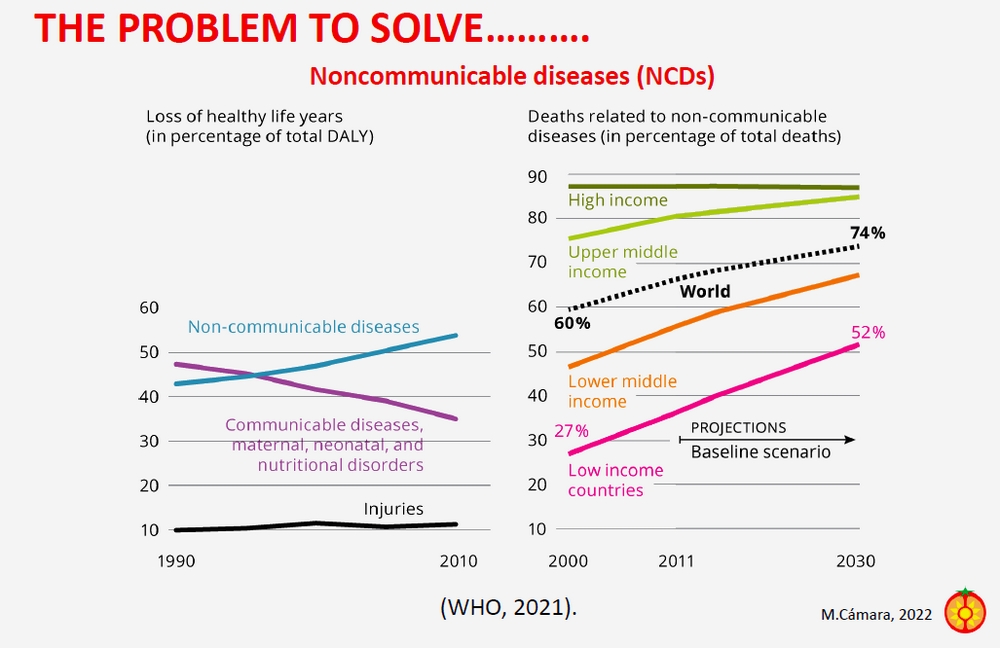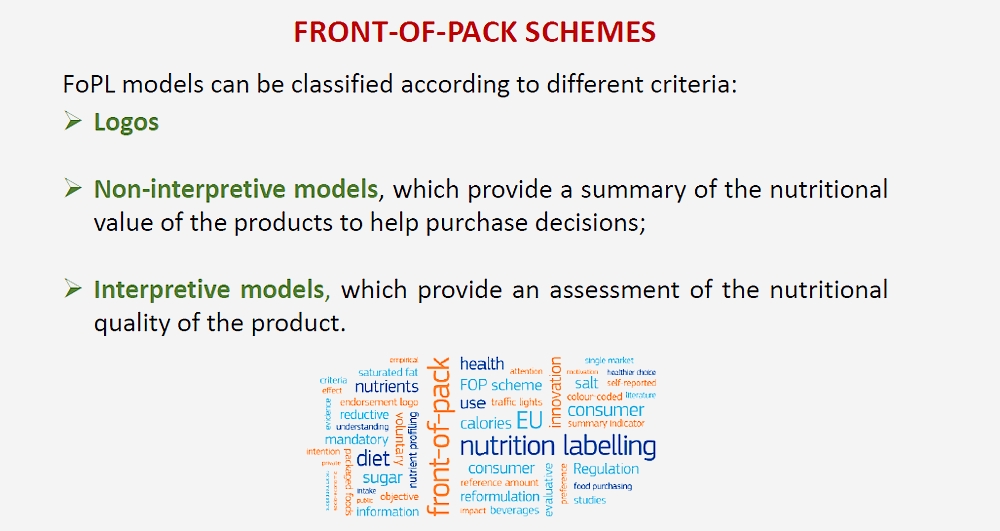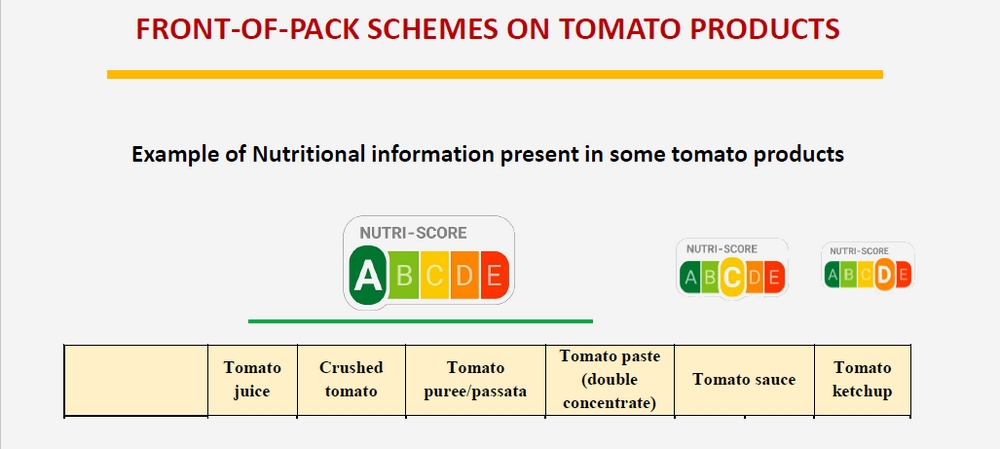From the presentation given by Pr. Montaña Cámara – Universidad Complutense de Madrid, during the 14th World Processing Tomato Congress (March 2022, held online from San Juan, Argentina): “Consumers' food choice and healthfulness perception. The impact of front-of-package nutrition labeling systems (FoPL, or f-o-p) on tomato products”.
 “First of all, I would like to thank and express my recognition to the president of the WPTC and all the organizers of this Congress for their great efforts to put the Congress together.
“First of all, I would like to thank and express my recognition to the president of the WPTC and all the organizers of this Congress for their great efforts to put the Congress together.Today I am going to talk about the consumers’ food choice and healthfulness perception, and particularly about the impact of front-of-pack (FoPL) nutrition labelling systems on tomato products.
As it has been mentioned in previous presentations, at present, excluding the Covid pandemic, non-communicable diseases in general and cardiovascular disorders in particular are the main cause of morbidity or mortality worldwide. As can be seen in this graph, this occurs in low-income countries as well as high-income ones – there is no difference.
If we consider which of the main risk factors could be preventable, we find that diet can be one of those, because the imbalance in the intake of salt and some other nutrients, particularly fats, sugars and fiber are the main preventable risk factors for these diseases. Jean-François Landrier has talked about diet and the relation between the intake of tomatoes and health, and that particular issue has been addressed, but all vegetable products can help to address this problem.
So, in consideration of this, all around the world, governments have approved health policies that aim to promote healthy diets. Their objective is to reduce obesity rates and guarantee nutrition and food safety. All governments want to improve the availability, accessibility and appeal of healthy food, and really focus on improving the health and well-being of citizens.
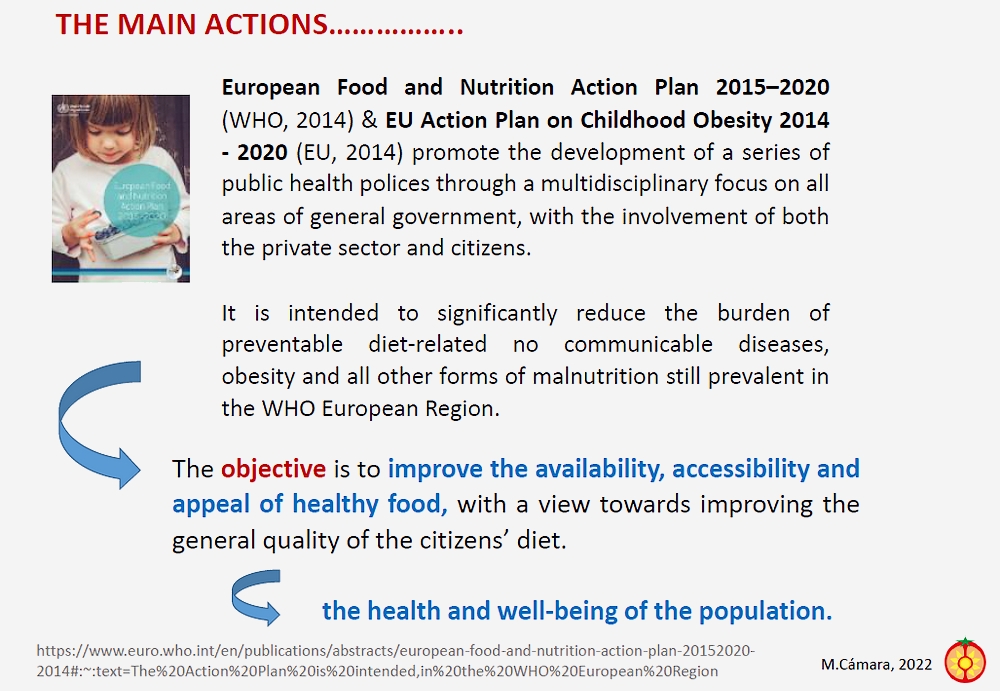
If we consider the nutritional information that is shown on food labels, its aim is to help consumers make better choices. Here are two tables to compare what is happening in all the Members States of the European Union and also what is happening in the United States. In the European Union, we have mandatory and voluntary nutrition information. European regulations require the vast majority of prepared foods to bear this nutrition declaration. It should be presented in a tabular format on the packaging, and only when there is not enough space to do that can the information be presented in a linear format. All the information is needed to be expressed either by 100 g or by 100 ml, depending on whether the food is solid or liquid. Usually, this mandatory nutrient declaration is often provided on the back of the food packaging. The content of this mandatory information can be supplemented in a voluntary form with the indication of monounsaturated fats, polyunsaturated fats, polyols, starch, fiber and micronutrients such as vitamins and minerals. A similar approach is used in the United States where you have nutrition facts labeling.
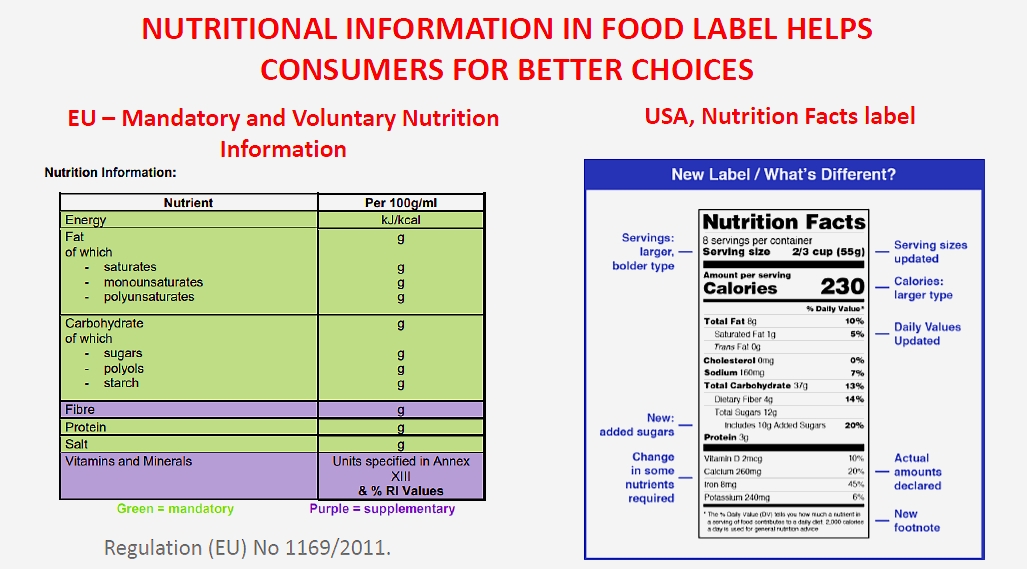
If we focus on voluntary nutrition information, different actions have been considered by the Codex Alimentarius, the European Commission, as well as the Pan-American health organization. At the international level, it is considered that this kind of voluntary nutrition information – this front of packaging labeling – could serve as an important policy implementation tool to promote healthy diet choices, and it can facilitate consumers’ understanding of the nutritional value of the food and therefore make healthy food choices. Furthermore, it can drive reformulation by the food industry.
I have to mention the case of the United States – I am not an expert on US law – but it looks like the first amendment protects companies from laws that restrict and compel certain types of speech included on the food label, and that is the reason why the first amendment has to be considered in any kind of front of package definition or any kind of a scheme that could be applied. As far as I know, at the present time, there is no mandatory f-o-p labeling in the United States.
The objective of this presentation is to provide an update of the different f-o-p nutrition labeling systems already available worldwide, as well as to examine the implications of their specific application to tomato products, in order to help professionals within the industry, including in the quality and marketing branches, to underline the value of the products.
Among the different f-o-p schemes, there are three main groups.
First are the logos. Then we have the non-interpretive models, which provide a summary of the nutritional value of the products to help purchasing decisions. And finally we have the interpretive models that provide an assessment of the nutritional quality of the product.
Starting with the logos, we have things like the Choice logo that is used in Belgium, the Czech Republic, the Netherlands, and Poland. We have the Green endorsement logo that is used in Israel, the Healthy living guarantee mark in Croatia, the Heart symbol in Finland, the Keyhole logo that we find in Denmark, Iceland, Lithuania, Norway and Sweden, as well as a logo used in Slovenia for protective food – the Little heart logo.
If we look at other types of f-o-p schemes, we have the nutrient specific warning system with the Red warning label that is used in Israel as a mandatory logo and is focused mainly on salt, sugar and fat content. Another type of scheme is the nutrient-specific interpretive system. A good example of this is the Traffic light that was developed in the United Kingdom and has been implemented in Ireland and Ecuador. I will talk later about this Traffic light. The last point is the summary indicator system – an example of which is the Nutri-Score, developed in France and Belgium and adopted in different countries, which I will mention later.
Each color has a meaning. Red means that the food or drink is high in a particular nutrient that consumers should try to cut down on, eating less of the product or in smaller quantities. Amber means medium content of the nutrient, allowing consumers to eat more of the product while staying healthy. Finally, green means low content of certain nutrients signaling the healthiest food choices. The general recommendation could be stated as: “Choose many greens and avoid too many reds”, but sometimes that interpretation is a bit simplistic.
To better describe the schemes that are most frequently implemented, I should start with the UK Traffic light established by the Food Safety Agency. In this scheme, the color code corresponds to a percentage of the recommended intake of calories. In this example for one type of food, the system states levels of energy, with the amount of saturated fats, sugars and salt, graded according to color (green, yellow or red), as well as the percentage of calories that each nutrient can give. In the examples here, we can see that when food is very rich in sugar, it is signaled in red because a single portion contains almost 40% of the recommended daily intake of sugar calories. What is stated is not just the amount of sugar, but the calories provided by sugars. The reference is always an adult reference intake. The algorithm used by the Food Safety Agency in the United Kingdom has been extensively studied in scientific literature and is the most frequently validated. It has been implemented in Australia, New Zealand, and France.
The next one is the Nutri-Score. Nutri-Score is based on the previously mentioned traffic light system and was developed in France by an academic research team including the French High Council for Public Health and the French Food Safety Agency. It was adopted officially in France in 2017. It is a summary indicator scheme based on an algorithm giving positive and negative points that build up and provide the food with a final score. Depending on that final score, food products are classified in five categories that are colored through green to red with letters from A to E.
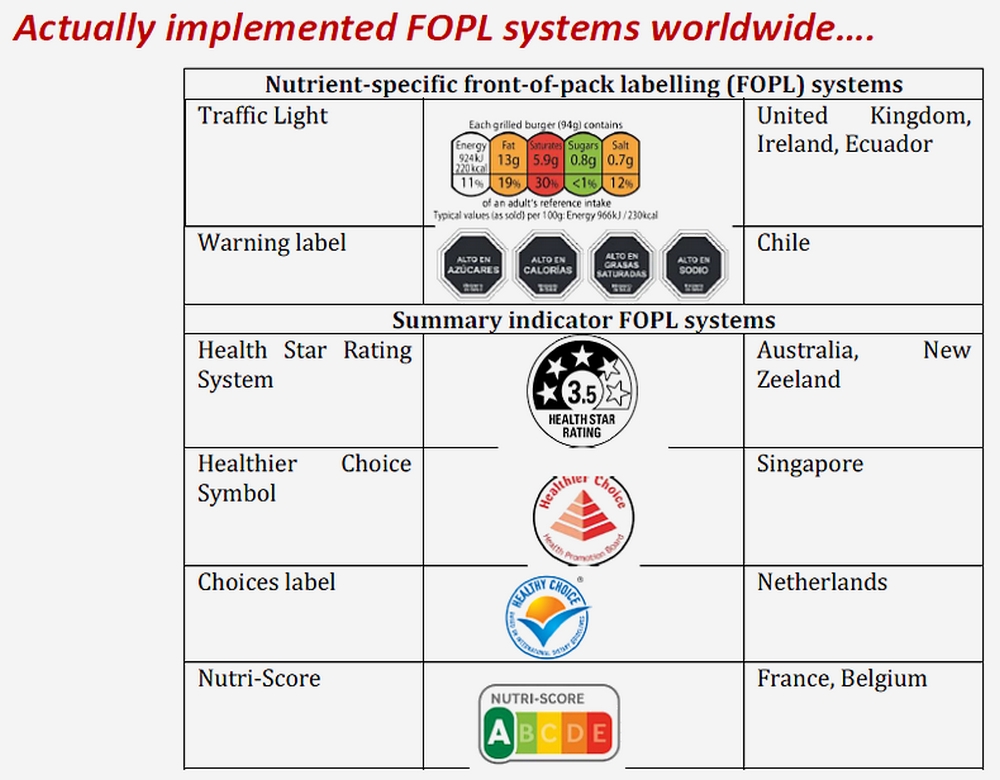
As a summary indicator scheme, Nutri-Score gives positive points and negative points. It penalizes the content of nutrients like salt, sugar and fat, as well as calories, of which consumption should be limited. These are the A points. Nutri-Score also gives favor points to those nutrients or ingredients of which consumption should be promoted. Among these are fruits, vegetables, pulses and nuts, together with fiber and protein. Depending on the final calculation, food products are graded with one color and one letter.
This system and its algorithm have been modified at the suggestion of different countries. This has been the case in France with evaluating cheese and also in Spain with evaluating olive oil. The main problem of Nutri-Score is that comparisons between products should be done within the same category – no one can make a comparison between cookies and tomato products or tomato products and drinks. It has to be within the same category, which is the only way to really be able to have a good understanding of the scheme.
In recent years, Nutri-Score has been implemented in different countries, either on a mandatory or a voluntary basis. It has been reviewed, and the result of this review has just recently been published at the beginning of March 2022. The steering committee will continue working on the management of the Nutri-Score and most probably the algorithm will be reviewed before this summer 2022. In the event that the Nutri-Score algorithm should be changed, the Commission will put out a support document for industry and business operators in order to facilitate implementation, because as I mentioned before, it is not an easy task – it depends on the composition of the food and the category of that food.
Another scheme that can be found worldwide is the nutritional warning that has been applied in the Pan-American region. This scheme is only for nutrients or compounds that are in high quantity or even in excess quantity. It is focused on fats, sodium and sugars, as well as calories. It has been implemented in Mexico, Chile, Peru, and Uruguay, and is voluntary in other countries.
Mention should be made of the NutrInform battery developed in Italy. Italy found that the algorithm of the Nutri-Score system unfairly discriminated against the country’s most famous foods, such as olive oil, Parma ham and Parmigiano cheese. Under the Nutri-Score system, these products would receive a red to orange warning on the labels due to their high content in fat and salt. So they developed a representation with a battery symbol for each nutrient, representing the percentage of energy value, fats, saturated fats, sugars and salt provided by one individual portion of each food product, with respect to the recommended amount of the daily intake. The graph is represented as a battery, and the problem with this scheme is that, for the general population, if you see in the graph that the battery is fully charged, you might think that it is more healthy. However, the real meaning is that the content of that nutrient or ingredient is very high. So, it can be considered to be the opposite of the nutrient score.
To date, there are not too many studies available on the level of understanding or usefulness of this NutrInform battery representation, because it has not been implemented in other countries besides Italy, where it is voluntary.
Here are the f-o-p schemes that have actually been implemented around the world.
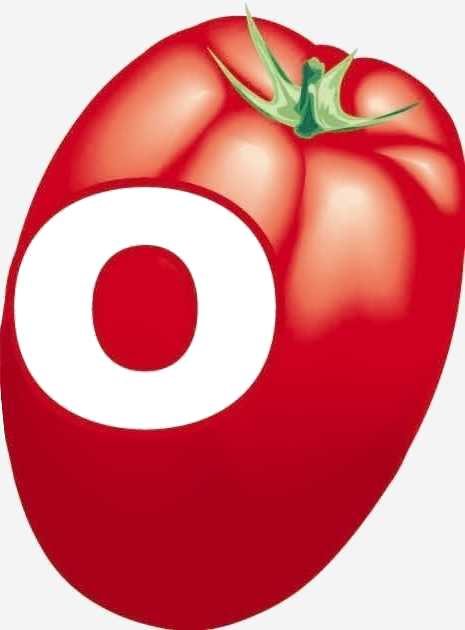 the Traffic light in the United Kingdom, Ireland and Ecuador, and there are probably more countries than the ones showed in this table;
the Traffic light in the United Kingdom, Ireland and Ecuador, and there are probably more countries than the ones showed in this table; the Warning label in the Pan-American region (for example Chile);
the Warning label in the Pan-American region (for example Chile); the Health Star rating system implemented in Australia and New Zealand;
the Health Star rating system implemented in Australia and New Zealand; the Healthy Choice symbol in Singapore;
the Healthy Choice symbol in Singapore; the Choice label in the Netherlands;
the Choice label in the Netherlands; and Nutri-Score in France and Belgium. At the beginning of March 2022, it was implemented also in the Netherlands, and I think they are going to implement it in Germany and Switzerland. In Spain, it is just voluntary.
and Nutri-Score in France and Belgium. At the beginning of March 2022, it was implemented also in the Netherlands, and I think they are going to implement it in Germany and Switzerland. In Spain, it is just voluntary.
After reviewing the different f-o-p schemes, I am going to focus on their effects on tomato products. This table is just an example of nutritional information that can be found on some tomato products. We have taken this information from products available on the Spanish market – I am sure that some of your products have similar nutrient information, while some may be a little bit different.
To make all the calculations and how it can be adjusted to the different f-o-p systems, we have to take into account the energy values, the fat (being specific as to the amount of saturated fat), main carbohydrates, free sugars, the possible presence of dietary fiber or not, protein and salt. These are the main components.
If we take these numbers into account (this table is just an example as I mentioned before) and we apply the algorithm from Nutri-Score, which is one of the most widely used in Europe (either mandatory or voluntary), we see that tomato juice, crushed tomato, tomato puree, passata and tomato paste will be classified as “A” with the color green. This is mainly because these products are of course 100% tomato-based products – so they contain more than 80% of fruit, providing positive points, and they also have a very low energy value, a very low calorie content.
If we look at other products like tomato sauce, things change because the fat content of tomato sauces is very variable, and is generally higher than the previously mentioned products, along with the salt content. So the green “A” changes to a yellow “C”. This product is classified more in the middle. Then, if you take some of the tomato ketchups, things change again and products can receive an orange “D” grade due to the high content – or potentially high content – of carbohydrates and especially salt. All these products have a salt content above the level of the general recommendations, at least for the negative points of Nutri-Score. If we consider the symbols that are used in the Pan-American region, we will see that these products will be labeled as “high in sugar” and also “high in sodium”.
The last part of this presentation deals with the effects of the f-o-p schemes on consumer food choices. All the systems that have been mentioned have been the subject of an intense debate over the last five years all over the world. It is recognized that f-o-p schemes have the potential to help consumers to make health-conscious food choices, as well as to support strategies for the prevention of diet-related non communicable diseases. But all f-o-p schemes must meet some general criteria to be really useful. They should not be misinterpreted by consumers. They must not be ambiguous or confusing and should be based on relevant criteria. F-o-p labeling can help consumers choose food and drink products, checking which of them are high in fat, sugar or salt. It should be taken into consideration that some products may contain high amounts of sugars but may nonetheless be healthy choices if they contain a lot of fruit as indicated in the ingredient list. So it is more complex than just putting a color on a specific compound, because we have to take account of the general composition and the food product as a whole.
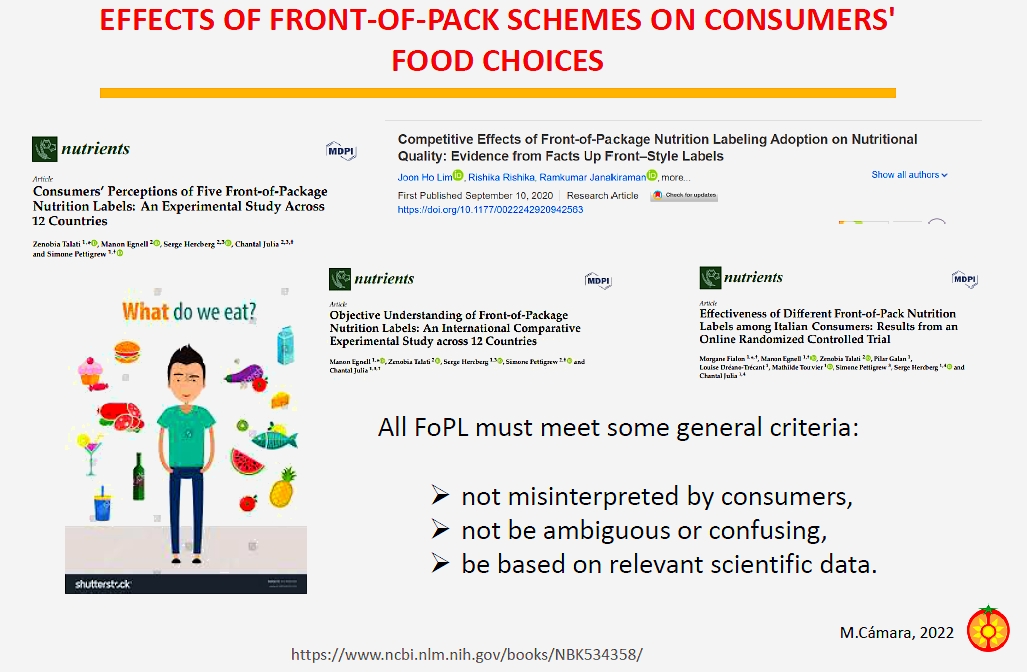
In 2020, the European Commission published a report on f-o-p nutrition labeling based on a literature review performed by the Joint Research Center. This was a scientific publication concerning the effects of these schemes on consumer understanding, the purchasing of food products and diet and health issues, as well as food reformulation. They also considered other potential effects and impacts, intended or unintended, introduced by f-o-p schemes.
At the end, recommendations generally match those of the World Health Organization. If we want to have a healthy diet, we should base meals on starchy foods such as whole grain bread, pasta and rice. We should eat a lot of fruit and vegetables. We should intake also some protein-rich foods such as fish, meat, pulses, milk or dairy food, though currently, all protein foods are under review. And we should keep our diets low in sugars and fat and saturated compounds, etc.
These f-o-p schemes can be considered also as a driver for industry innovation. Labeling can stimulate innovation and product reformulation, and this reformulation can have a positive dietary change across the population even when people are not conscious about the decision-making process, because the foods on offer are really healthier.
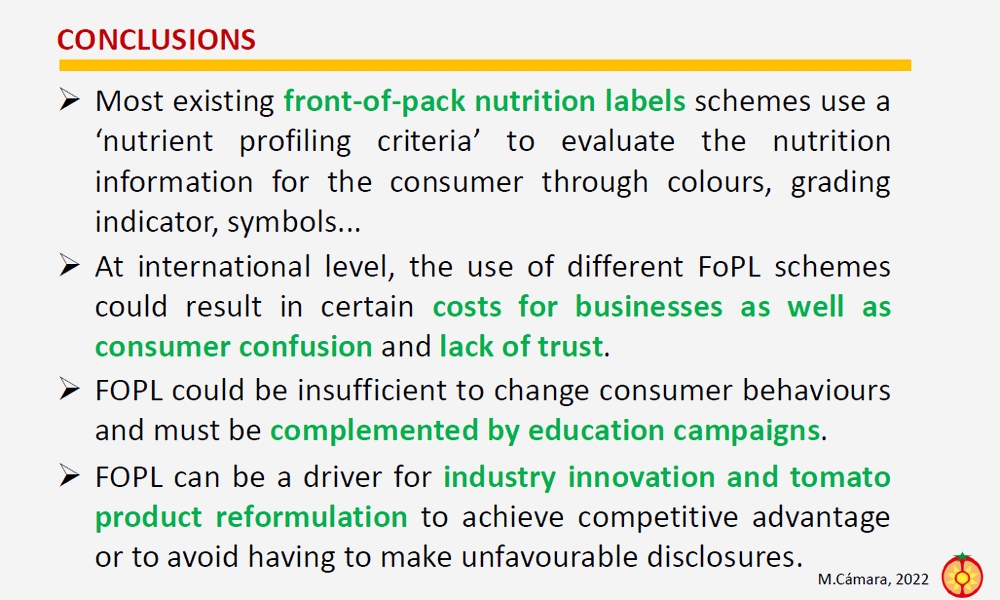
My conclusions are that most existing f-o-p nutrition labeling schemes use the “nutrient profiling criteria” to evaluate the nutrition information for consumers through colors, grading indicators or symbols. At the international level, I consider that the use of different f-o-p schemes could result in increased costs for businesses as well as consumer confusion and lack of trust. F-o-p labeling could be insufficient to change consumer behaviors and must be complemented by education campaigns. F-o-p labeling can be also a driver for industry innovation in the tomato sector, with product reformulation aimed at achieving a competitive advantage, whilst avoiding unfavorable disclosures and enhancing the value of products.”
Some complementary data
Video is available at:
Sources: World Processing Tomato Congress (whova.com)



